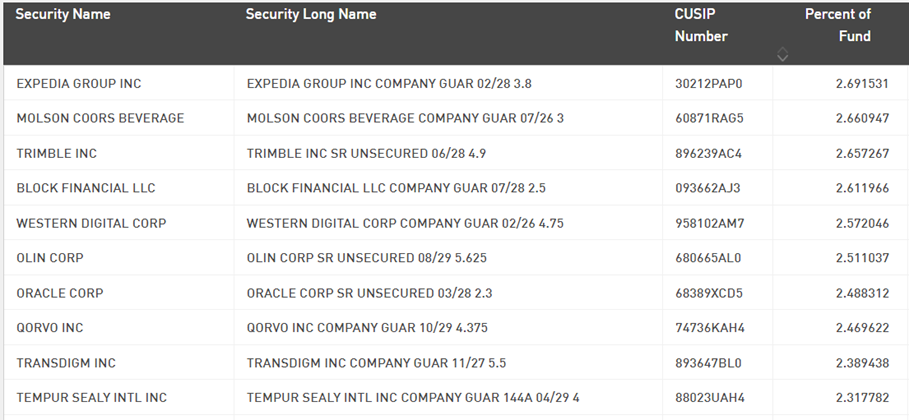Portfolio Commentary
During the fourth quarter of 2022, the iMGP Dolan McEniry Corporate Bond Fund had a return of 2.77%, finishing slightly ahead of the Bloomberg U.S. Intermediate Credit benchmark’s return of +2.52%.
Institutional Class launch date is 9/28/2018. Advisor Class launch date is 5/17/2019. Benchmark Since Inception is as of the Institutional Class Inception date.
Performance quoted represents past performance and does not guarantee future results. The investment return and principal value of an investment will fluctuate so that an investor’s shares, when redeemed, may be worth more or less than their original cost. Current performance of the funds may be lower or higher than the performance quoted. Short term performance is not a good indication of the fund’s future performance and should not be the sole basis for investing in the fund.To obtain standardized performance of the funds, and performance as of the most recently completed calendar month, please visit www.imgpfunds.com. There are contractual fee waivers in effect through 4/30/2023. In the absence of such waivers, total return would be reduced.
Market Review
During the fourth quarter, the Federal Reserve continued to increase the lower bound of the Federal Funds Rate, lifting it from 3.00% to 4.25%. Treasuries were mixed on the outcome of rate hikes as some participants may believe the Federal Reserve is closing in on the peak of its hikes. Over the three-month period, corporate investment-grade and corporate high-yield spreads tightened. Today, yields are substantially higher and are among the highest they have been in over a decade. Overall, credit quality remains strong although there have been pockets of fundamental deterioration. Dolan McEniry will continue to monitor markets for any opportunities that may arise.
During the quarter, Treasury rates were mixed, and the curve remained inverted as the 10-year U.S. Treasury yield increased from 3.83% to 3.88%, the 5-year yield decreased from 4.09% to 4.01% and the 2-year yield increased from 4.28% to 4.43%.
Per Bloomberg data, spreads on corporate investment-grade bonds tightened 29 basis point during the quarter to an average option adjusted spread (“OAS”) of +130 basis points. The OAS of the Bloomberg Barclays Corporate High Yield Index tightened 83 basis points to +469 basis points at quarter end.
On a relative basis, the iMGP Dolan McEniry Corporate Bond Fund outperformed the Bloomberg U.S. Credit Intermediate Index by 25 basis points. The fund’s outperformance was driven by its relative outperformance in corporate investment-grade and overexposure to high-yield bonds as opposed to government-related securities. The yield curve positioning and duration had a minimal effect on relative performance versus the benchmark.
Outlook and Strategy
Dolan McEniry believes that client portfolios are positioned to provide reasonable absolute and relative returns going forward. Dolan McEniry’s core competence is credit analysis, and we focus on a company’s ability to generate generous amounts of free cash flow over time in relation to its indebtedness. Investment safety and risk mitigation are of primary importance as we continue to search for undervalued fixed-income securities. As of December 31st, the IMGP Dolan McEniry Corporate Bond Fund had an +62 basis point yield premium and similar duration versus the Bloomberg U.S. Intermediate Credit benchmark. We believe these stats will allow the portfolio to perform well versus the benchmarks over time.
Performance and Stats
| Performance | iM Dolan McEniry Corporate Bond Fund | Bloomberg U.S. Intermediate Credit |
| December 2022 | -0.01% | -0.08% |
| 4th Quarter 2022 | +2.77% | +2.52% |
| Year to Date | -8.08% | -9.10% |
| 12/31/22 Stats | iM Dolan McEniry Corporate Bond Fund | Bloomberg U.S. Intermediate Credit |
| Yield to Worst | 5.84% | 5.22% |
| Yield to Maturity | 5.84% | 5.22% |
| Effective Duration | 3.52 Years | 4.01 Years |
| Average Coupon | 4.09% | 3.19% |
Attribution Commentary
Yield Curve and Duration: The yield curve positioning and duration had a minimal effect on the performance versus the benchmark.
Commentary:
During the quarter, the iM Dolan McEniry Corporate Bond Fund outperformed the Bloomberg U.S. Credit Intermediate Index by 25 basis points. The fund’s outperformance was driven by its relative outperformance in corporate investment grade and overexposure to high yield as opposed to government related securities.
Security Selection
| Top Performers | Bottom Performers |
| TransDigm Group Inc. | AMC Networks Inc. |
| Boyd Gaming Corp. | Qurate Retail Inc. |
| DaVita Inc. | Tempur Sealy International Inc. |
